BIOLOGY (THEORY)
PAPER 2
TIME: 2 HOURS
INSTRUCTIONS TO CANDIDATES
- This paper consists of two sections A and B.
- Answer ALL questions in section A
- Answer question 6 (compulsory) and either question 7 or 8 in section B.
For Examiner’s Use Only
Section Question Maximum score Candidate’s score
|
Section |
Question |
Maximum score |
Candidate’s score |
|
A |
1 2 3 4 5 |
8 8 8 8 8 |
|
|
B |
6 7 8 |
20 20 20 |
|
|
Total Marks |
80 |
|
|

QUESTIONS
SECTION A (40 MARKS)
Answer all questions in this section.
1. The diagram below shows a cross section through the female part of a flower.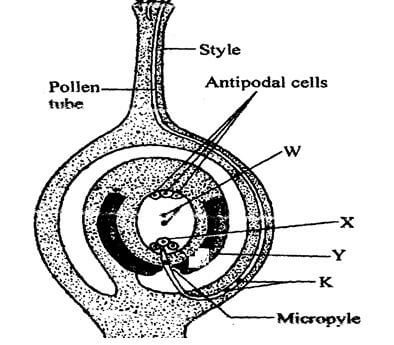
- Name the structures labeled W,X, and Y. (3mks)
W .....................................................................
X .......................................................................
Y ....................................................................... - State two functions of the pollen tube. (2mks)
- What happens to antipodal cells after fertilization. (1mk)
- Name the structure labeled K and state their role. (2mks)
2. The diagram below illustrates and experiment to determine the rate of respiration in a small insect.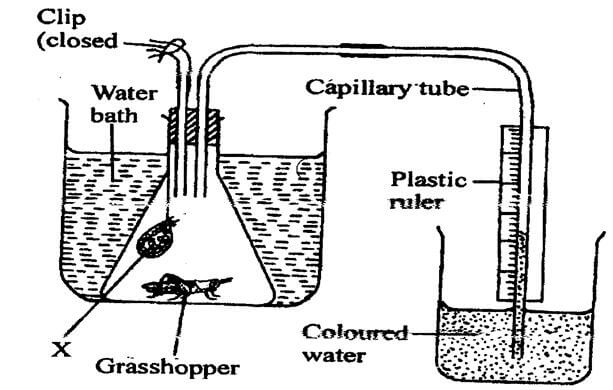
- Name the chemical compound labeled X and state its function. 2mks)
- Why is it necessary to place the flask in a water bath. 3mks)
- What changes would you expect to observe in the level of coloured water in the capillary tube after the experiment has run for five minutes. (1mk)
- Explain the changes you have started in ( c) above. (3mks)
- State how you can set up a control experiment . (1mk)
3. The diagram below shows some components of a light microscope.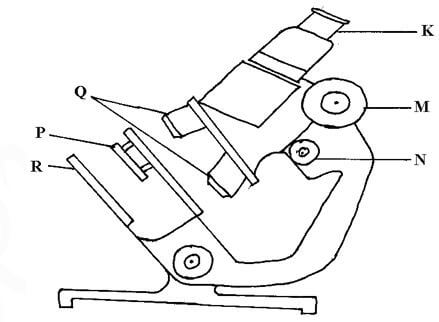
- Name the parts labeled (2mrks)
K ………………………………………………………………………………………………
M ……………………………………………………………………………………………… - State the functions of (2mrks)
P ………………………………………………………………………………………………
Q ……………………………………………………………………………………………… - A student was viewing a prepared slide of a plant cell under high power microscope. The features of the cell were blurred. Which one of the labeled parts of the microscope would the student use to obtain:-
- a sharper outline of the features. (1mrk)
- Give the formula used to calculate magnification in a light microscope. (1mrk)
- A student was preparing a section of a plant cell to be viewed on a light microscope. Give a reason for each of the following steps:-
- Cutting a very thin section (1mrk)
- Staining the section (1mrk)
- Putting the section in water (1mrk)
4. In an experiment, a black mouse was mated with a brown mouse; all the off-springs were
black. The off-springs grew and were allowed to mate with one another. The total number
of (F2) generation off-springs was 96.
- Using the letter symbols capital letter B for the gene of black colour and small b for brown colour, Work out the genotype of the F1 generation. (3mrks)
- From the information above, work out the following for the F2 generation.
- Genotypic ratio. (2mrks)
- Phenotypic ratio. (1mrk)
- The total number of brown mice (2mrks)
5. In a physiological experiment, starch, protein, diastase and sodium chloride were added to water and put inside a visking tubing. The visking tubing was then placed in a water bath maintained at a temperature between 35 --- 40°C. The set up was as shown in the diagram below.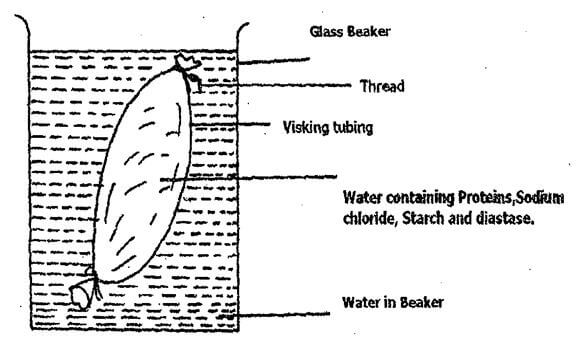
The following observations were made after the procedures indicated.
| Contents in | At the start of experiment | After 1 hour |
| Visking tubing | i) Solution tastes salty | Solution tastes salty |
| ii) Visking tubing is not firm | Visking tubing is firm | |
| iii) After boiling with Benedicts solution, solution remains blue | After boiling with Benedicts solution the solution turns brown | |
| iv) On addition of solution hydroxide followed by copper sulphate solution to the solution,the colour changes to purple | On addition of sodium hydroxide followed by coppers sulphate to the solution, the colour changes to purple | |
| Beaker | i) Water is tasteless | Solution tastes sweet/salty |
| ii) After boiling solution with Benedicts solution, Blue colour remains | After boiling solution with Benedicts solution, colour turns to brown | |
| iii) On addition to sodium hydroxide followed by copper sulphate solution, colour remains blue | On addition of sodium hydroxide followed by copper sulphate solution, colour remains blue |
- Name the process by which salt moved into the water in the beaker from the visking tubing. (1mark)
-
- Name the food substance responsible for the brown colour observed after 1 hour both in
the beaker and visking tubing when solutions are boiled with benedicts solution. (l mark) - Account for the observation in (b i) above. (3 marks)
- Name the food substance responsible for the brown colour observed after 1 hour both in
-
- Name the food substance tested with sodium hydroxide followed by copper sulphate solution(s) (1 mark)
- Account for the absence of the food substance named in (c i) above in the beaker after 1 hour. (l mark)
- After one hour the visking tubing was firm. State the term used to describe this state. (1 mark)
SECTION B( 40 MARKS)
Answer questions 6 ( compulsory)and either questions 7 or 8 in the spaces provided questions 8
6. An experiment was carried out whereby three healthy rats were fed on equal amounts of glucose. After half an hour, the glucose concentration per ml. of blood was measured at 15 minutes intervals for three hours. The following results were obtained.
15 min
| Glucose Conc. mg/ml | 0 min | 15 min | 30 min | 45 min | 60 min | 75 min | 90 min |
| Rats | |||||||
| A | 0.800 | 0.774 | 0.715 | 0.680 | 0.650 | 0.595 | 0.555 |
| B | 0.745 | 0.695 | 0.695 | 0.660 | 0.635 | 0.600 | 0.545 |
| C | 0.795 | 0.695 | 0.665 | 0.635 | 0.590 | 0.550 | 0.495 |
| Mean | 0.780 | 0.720 | 0.691 | - | 0.625 | - | 0.532 |
-
- Calculate the mean concentration of glucose in mg per ml of blood at 45 and 75 minutes. Record your answer on the table. (2mks)
- On the graph paper provided, plot a graph of the mean glucose concentration against time.(6mks)
- What was the mean glucose concentration in the blood after 37.5 minutes? (1mk)
- Give a reason why it was necessary to use three rats in the experiment instead of one. (1mk)
- Why was the initial concentration of glucose in the rats not the same? (2mks)
- Account for the difference in mean glucose concentration during the period. (3mks)
- Give two reasons why glucose is the main respiratory substrate. (2mks)
- Give three ways in which glucose is assimilated in the body. (3mks)
7.
- What assumption are made when using the captured recapture method in estimating population of animals. (5mks)
- Describe how you would use the capture – recapture method to estimate the population of fish in the school pond. (15mks)
8.
- Define natural selection. (2mks)
- Natural selection brings about adaptation of a species to the environment.
Discuss. (18mks)

Marking Scheme.
SECTION A (40 MARKS)
Answer all questions in this section.
-
- W – Polar nuclei; rej with cells
X – Ovum ( egg cell) ; rej. cells
Y- Integuments ; (3mks) -
- Dissolves the tissues of the stroma ,style and ovary ;
- Forms pathway for the male nuclei to reach the embryo sac; (2mks)
Rej.- allows for passage
- male nucleus for nuclei/ pollen grain
- They disintegrate ; (1mk)
- Male nuclei; carry out double fertilization. ;Rej nucleus (2mks)
- W – Polar nuclei; rej with cells
-
- Sodium hydroxide pellets; To absorbs the carbon (IV) oxides produced: rej test for carbon (IV) oxide
- To maintain a constant temperature during the period of the experiment ; a small rise in temperature causes air to expand ; a small fall in temperature causes air to contract ; leading to erroneous results; (3mks)
- The level of water in the capillary would rise; (1mk)
- The insect respired taking up oxygen ; releasing carbon (IV) oxide which is absorbed by Sodium Hydroxide; up take of oxygen caused a decrease in air pressure within the flask ; rej. CO2 for Carbon (IV) Oxide (3mks)
- A control can be set up by substituting a living insert with a dead one;
-
- K- eye piece
M-coarse adjustment knob. - P-concentrate the light/focuses the light.
Q- magnification of the image. Rej object/specimen for image - i) – N
ii) – Eyepiece magnification X objective lens magnification
Rej.- Length of the drawing
length of the actual
- Length of the drawing
- i) to allow light to pass through ;
ii) To make the features more clear and distinct; rej. Without distinct
iii) For cells to remain turgid/ prevent dehydration;
- K- eye piece
-
- Parental phenotype : Black mouse Brown mouse
Parental genotype : BB X bb ;
Gamete :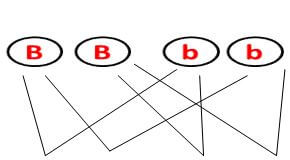
F1 generation : Bb Bb Bb Bb ;
Rej.- If it does not start from phenotype
- If X is not there at the genotype
- If X is placed at the gamates.
- If gametes are not circled
- If the circle has a tail or a gap- must be as smooth as possible.
- If the fusion lines do not touch the line of the circle or if it penetrates into the circle.
- If fusion lines join at the gamete.
- If fusion lines are not at the same level at the F1 generation.
- i) F2 offspring’s are BB, Bb, Bb, bb:
Genotypic ratio = 1BB:2Bb:1bb;
Rej. BB:Bb:bb
1 : 2 :1
ii) Phenotypic ratio -1brown: 3black ;
iii) ¼ x 96 = 24 ;
- Parental phenotype : Black mouse Brown mouse
-
- Diffusion;
- i) Reducing sugars/simple sugars/glucose;
ii) Diastase converts starch to reducing sugars; so present in visking tubing then due to small sized molecules of reducing sugar and semi-permeability of the visking tubing; the molecules moved across the semi-permeable to the beaker; so present both in the visking tubing and the beaker.(Rej- Second mark:-If size and semi permeability are not indicated) - i) Proteins; reject Amino acids
ii) The molecules of proteins are large/big so cannot pass through the pores of the semi-permeable membrane visking tubing - Turgid; Accept turgidity
SECTION B( 40 MARKS)
Answer questions 6 ( compulsory)and either questions 7 or 8 in the spaces provided questions 8
-
-
- At 45 minutes 0.6580 mg/ mp; (1 mark)
At 75 minutes 0.580 – 0.582 mg/ ml; - Check graph (6 marks)
Weaknesses- Drawing three graphs
- Using broken line
- Exchange of axis
- Use of a ruler to join points
- Not indicating the variables on the two axis
- Extending the curve beyond the last point
- Thick curve line
- Using zig zag on the axis
- No evidence on the graph on the estimated 37.5
- At 37.5 minutes 0.675 0.05 mg/ ml (1 mark)
(Evidence on graph to earn mark) - To obtain reliable results; (1 mark)
- The rats may have been different in terms of weight, sex, age; or had different rates of metabolism; (2 marks)
- Glucose decreased; due to conversion into glycogen; utilization to release energy;for accounting you must indicate the observation. (2 marks)
- At 45 minutes 0.6580 mg/ mp; (1 mark)
- It is highly soluble in the water, therefore easily transported to the sites of respiration; it requires relatively low oxygen to oxidise a unit mass of glucose than the other substrates; (3 marks)
- Oxidized to give energy, carbon (IV) oxide and water; converted to glycogen and stored in the liver; converted to fats and stored under the skin, around the kidneys etc; Rej. Without converted (3 marks)
Glocose is not used but oxidized.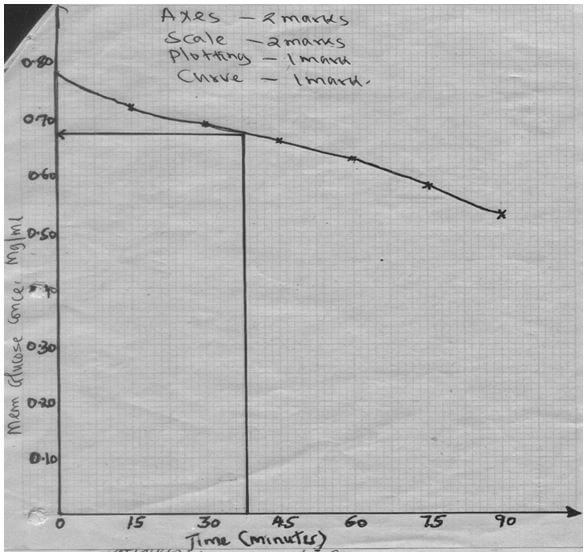
-
-
- Answers
- The animals when released mix freely and evenly with others;
- Marked animals will have enough time to mix freely and evenly with others;
- No immigration / emigration / migration of animals during the study period;
- No animal dies / born during the study period / the man does not change the balance of the animals or the others. (5mks)
- mark does not fade out
- mark on the animal does not expose it to the predator
- mark does not scare other animals
- Answers:
- Using a fish net ; catch as many fish as possible ; place the caught fish in a basin / pail with water ; count; mark the fish with a light coloured water proof paint / nail vanish; record the number caught and marked / first marked (FM);
- Release the fish back to the pond;
- After 24 hrs to 3 days ; use the same net to catch as many fish as possible ;
- Second catch (sc); and those caught with marks ie marked recapture (MR) return all the fish back to the pond;
If p is total population ;
Then: FM = MR
P SC
Hence P = FM × SC
MR
Rej. - Use a bucket basket to catch the fish
- Catch a few/some fish
- Give the fish sometime
- Counting without recording or recording without counting
- Use fish trap
- Not placing the fish in a basin when counting
- First trip instead of capture
- Set aside a section of the school fish pond
- Using fish net get to the fish pond and fish out the fish.
- Take the number of the captured fish
- Through head count find the population
- Make sure the fish pond is save to carry out capture recapture method.
- Answers
-
- Process by which nature selects those individuals which are sufficiently well adapted to the environment and allow them to survive; but rejects those that are poorly adapted.(2mks)
- Individuals of same species show certain variations; which are caused by genes; and the variations can be passed from parents to their offsprings; through genetic inheritance; some of the variations or characters become more suited to the prevailing environment condition; due to selection pressure or competition; most organisms tend to produce more offsprings that the environment can support; this leads to struggle for existence; among the individual species e.g food, water, shelter, mates; due to stiff competition; individuals that posses characteristics that enable them to have competitive advantage stand a better chance of survival in the struggle; the result is that well adapted individuals survive; and their reproductive age; from where they pass on their desirable genes/ trails to their offsprings; those that are poorly adapted; fail to reach their reproductive age; and hence does not pass over the poor traits to their offsprings; and thus perish to allow the fittest survive. (max 18mks)
Download Biology Paper 2 Questions and Answers - Form 4 End Term 2 2021.
Tap Here to Download for 50/-
Get on WhatsApp for 50/-
Why download?
- ✔ To read offline at any time.
- ✔ To Print at your convenience
- ✔ Share Easily with Friends / Students

